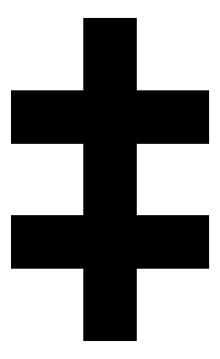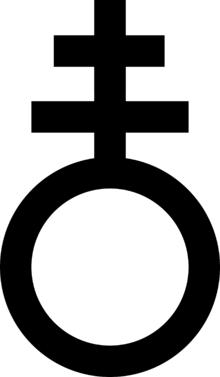Two-barred cross
A two-barred cross is similar to a Latin cross but with an extra bar added. The lengths and placement of the bars (or "arms") vary, and most of the variations are interchangeably called the cross of Lorraine, the patriarchal cross, the Orthodox cross or the archiepiscopal cross.[1]

The two bars
The two bars can be placed tight together (condensed) or far apart. They can be symmetrically spaced either around the middle, or above or below the middle. One asymmetrical variation has one bar near the top and the other just below the middle. Finally the bars can be of equal length, or with one shorter than the other.
Decorations
The ends of the arms can be decorated according to different styles. A style with round or rounded ends is called treflée or botonée (from French bouton) in heraldic use. The same style is called budded, apostles' or cathedral cross in religious use.[2] A straight and pointy style called pattée also includes maltese cross variations,[3] and finally a pointed style called aiguisé.[4]
Heraldic use
.svg.png)


The crosses appear in heraldic use in the second century A.D.[5] A balanced cross is used in the Coat of arms of Hungary as well as in several small shields within shields of Vytis. An outlined balanced cross (equal length outlined bars on equal distances) is used on coat of arms shields and order medals [6]
In Slovakia, the flag, the coat of arms and several municipal symbols include a double cross, where graded bars are more common than equally long bars, and balanced distances along the vertical line are more common.[7]
The two-barred cross was also, since around the year 1140, used in Kopnik, Branibor (currently Berlin, Brandenburg) as seen on one of the five emissions of the silver bracteate of Iakša (Jaxa), a Christian state, fief of Poland (archbishops of Gniezno), coined until its invasion and destruction by Germanic "Wendish Crusade" of 1147.
In print
In typography the double cross is called double dagger, double obelisk and diesis.[8]
In medicine and botany
The International Union Against TB and Lung Diseases is since 1902[9] using a red cross variation in its logotype. The two equally long bars are on the upper half of the cross and all six ends are aiguisé.[10]
In botany a balanced cross (equal length bars on equal distances) is used to mark very poisonous plants [11]
Gallery


 Orthodox cross
Orthodox cross
 Double obelisk
Double obelisk
References
- "Group 3:6". symbols.com. Archived from the original on March 8, 2010. Retrieved June 10, 2010.
- "The Budded Cross". seiyaku.com. November 25, 2008. Retrieved July 17, 2015.
- "St. John's Cross". seiyaku.com. November 25, 2008. Retrieved July 17, 2015.
- "Passion Cross and Nail Cross". seiyaku.com. November 25, 2008. Retrieved July 17, 2015.
- "Cross Lorraine". freemasonry.bcy.ca. July 13, 2009. Retrieved July 17, 2015.
- "Group 28:38". symbols.com. Archived from the original on June 10, 2009. Retrieved June 9, 2010.
- "Slovac genealogical-heraldic society". genealogy-heraldry.sk. Archived from the original on July 22, 2015. Retrieved July 17, 2015.
- "Obelisk, Obelus, Dagger". seiyaku.com. November 25, 2008. Retrieved July 17, 2015.
- "Medical Crosses". seiyaku.com. November 25, 2008. Retrieved July 17, 2015.
- "About Us: The Cross of Lorraine – a symbol of the anti-TB "crusade"". tbalert.org. Archived from the original on March 2, 2009. Retrieved June 10, 2010.
- "Group 9:8". symbols.com. Archived from the original on July 1, 2009. Retrieved June 9, 2010.
- "Group 20:28". symbols.com. Archived from the original on November 29, 2006. Retrieved June 9, 2010.